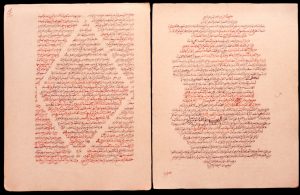Introduction
In April, the University Library celebrated the preservation of the Charles Stewart Mauritanian Arabic manuscripts, which is the most extensive collection of Sub-Sahar manuscripts in North America. Prof. Charles served for 35 years in the Department of History, and for half of that time held administrative posts as Director of African Studies, Associate Chair, then Chair of History, Executive Associate Dean in the College of LAS and Interim Associate Provost for International Studies, before his retirement in 2006.
According to Stewart, the collection has 10,000 manuscripts, and it covers topics such as jurisprudence, devotions, science, Quran, history, langaugestics, Sufism, politics, and economics.
The celebration of the collection also had an exhibit that was created by Atyeh (Ati) Ashtari and an online LibGuide created by Lauryn Lehman.
Laila Hussein Moustafa, Assistant Professor, Middle Eastern and North African Studies Librarian
The Exhibition

Panels about the Caliphate are on display in the IAS Library through mid-May.
“Working on an exhibition to showcase Caliphate of Hamdallahi exposed me to many challenges. In order to create a successful exhibition, you need to come up with highly visually pleasing graphics to make the intended audience interested in the work. However, this particular topic did not have any easily accessible visual materials such as photos, images and manuscripts. Therefore, we had to spend hours digging up the relevant information. Moreover, we had to be very innovative to come up with ways of visualizing the gathered data in a way that is both interesting as a text and much more fascinating as a graphic. This is very well indicated in our poster presenting the challenges of studying the Sokoto Caliphate. We wanted to convey that the two most challenging part of this study was that the material was diffused all over the world and that the data was in many different languages. To visualize these amazing facts, we ended up building layers of graphics on top of a world map to depict such challenges.”
Atyeh Ashtari, Graduate Research Assistant for Urban and Regional Planning
The Online LibGuide
“This semester, we have been in the process of developing a library guide to aid researchers in locating West African Arabic and Arabic-script resources to use in their research. The initial focus was on finding as many open-access resources as were available, though the scope has expanded outwards to include any relevant resources that could be found. We were able to successfully locate a number of digitization projects that have made resources openly available, as well as an extensive list of physical archives, both domestically and internationally, that researchers may visit. Additionally, we are in the process of creating an interactive map, to further aid in the finding of resources. We look forward to adding new materials as further projects make them available.”





